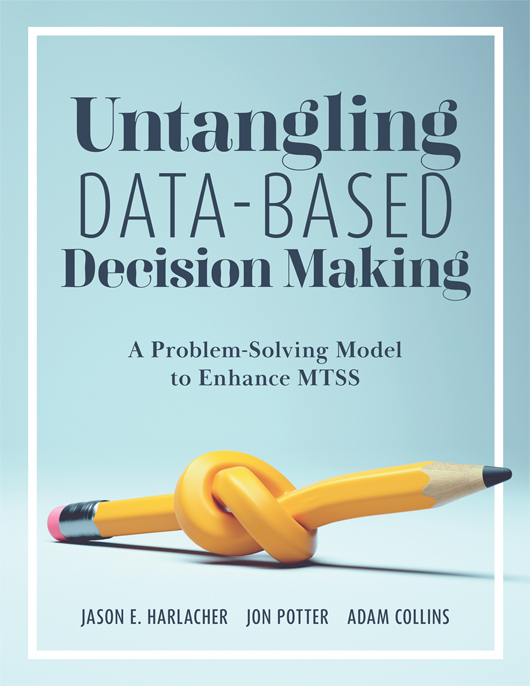Free Reproducibles
Untangling Data-Based Decision Making
A Problem-Solving Model to Enhance MTSS
Learn how to use a problem-solving model to easily make sense of student data, enabling teams to effectively drive instruction and plan appropriate responses within a multitiered system of supports (MTSS).
Benefits
- Understand the proper application of data-based decision making
- Successfully utilize data to improve student learning
- Use worksheets and tools to organize data team meetings
- Become data rich and information rich
- Develop an MTSS within their school or district
TABLE OF CONTENTS
Chapter 1: Overview of Multitiered System of Supports
Chapter 2: Defining Data-Based Decision Making
Chapter 3: Data-Based Decision Making at the Schoolwide Level
Chapter 4: Data-Based Decision Making at Tier 1
Chapter 5: Data-Based Decision Making at Tier 2 for Groups of Students
Chapter 6: Data-Based Decision Making at Tier 3 for Individual Students
STUDY GUIDE
REPRODUCIBLES
Chapter 1
Chapter 2
- Figure 2.6: RIOT/ICEL Matrix and Examples of Ways to Assess Variables
- Figure 2.7: The Instructional Hierarchy and Its Stages
Chapter 3
- Figure 3.8: General Features of Tier 1 Standards of Practice
- Figure 3.9: Sample Standards of Practice Fidelity Form (Reading and Writing Instruction)
- Figure 3.10: Examining Your System Capacity and Infrastructure to Support Implementation
- Schoolwide Tier 1 Worksheets for Problem-Solving Model
- Sample Tier 1 Reading Standards of Practice
Chapter 4
- Figure 4.7: Priority Skill Hierarchy Template
- Figure 4.9: Possible Instructional Evidence-Based Strategies and Routines to Incorporate Into Tier 1 Gradewide Plans
- Figure 4.10: Possible Curriculum Evidence-Based Strategies and Routines to Incorporate Into Tier 1 Gradewide Plans
- Figure 4.11: Possible Environmental Evidence-Based Strategies and Routines to Incorporate Into Tier 1 Gradewide Plans
- Figure 4.12: Public Display of Data Template
- Figure 4.13: Example of an Implementation Checklist for Tier 1 Plan
- Figure 4.16: Plan for Tier 1
- Grade-Level Tier 1 Worksheets for Problem-Solving Model
Chapter 5
- Figure 5.12: Example of a General Fidelity Checklist
- Tier 2 Worksheets for Problem-Solving Model
- Example Questions to Ask for Individual Problem Analysis at Tier 2
Chapter 6
- Figure 6.10: Observation Template for Praise
- Figure 6.11: Questions for Classroom Management
- Figure 6.13: Instruction Factors to Adjust for Designing Plans
- Figure 6.14: Curriculum Factors to Adjust for Designing Plans
- Figure 6.15: Environment Factors to Adjust for Designing Plans
- Figure 6.18: Generic Fidelity Tool
- Tier 3 Worksheets for Problem-Solving Model
- Classroom Management Observation Tool (CMOT)
- Interest Inventory for Secondary Students
SUGGESTED RESOURCES
Books
- DuFour, R., DuFour, R., Eaker, R., Many, T. W., & Mattos, M. (2016). Learning by doing: A handbook for Professional Learning Communities at Work (3rd ed.). Bloomington, IN: Solution Tree Press.
- Harlacher, J. E., & Whitcomb, S. A. (2022). Bolstering student resilience: Creating a classroom with consistency, connection, and compassion. Bloomington, IN: Marzano Resources.
- Marzano, R. J. (2018). Making classroom assessments reliable and valid. Bloomington, IN: Solution Tree Press.
WEBSITES
- Best Evidence Encyclopedia
- Center on Instruction
- Evidence-Based Intervention Network
- National Center on Intensive Intervention Tools Charts
- What Works Clearinghouse Practice Guides
- FastBridge
- Measures of Academic Progress
- Star Assessments
- Strengths and Difficulties Questionnaire
- Phonics Inventory
- Primary Spelling Inventory
- Star CBM Reading
- Star CBM Math
- Read Naturally
- Phonics for Reading
- Reading Rockets Phonemic Awareness Assessment
- Northwest Evaluation Association Measures of Academic Progress
- Renaissance Star Assessment
- Direct Behavior Ratings
- Direct Behavior Rating Overview
- RTI Action Network
- National Center on Intensive Intervention’s Example Diagnostic Tools table
- IRIS Center: Error Analysis for Reading
- WestEd’s Doing What Works: Systematic Analysis of Student Errors protocol
- WestEd’s Doing What Works: Reading Skills Error Analysis Sheet
- Center on PBIS
- Forced-Choice Reinforcement Menu
- Visible Learning
- High-Leverage Practices
- High-Leverage Practices for Students With Disabilities
- Levels of Intervention and Evidence
- Acadience
- AimswebPLUS
- Dynamic Indicators of Basic Early Literacy Skills
- Acadience Reading Diagnostic
- Phonics Inventory
- Phonics Spelling Inventory
- SpringMath
- Star Phonics
- Intervention Central
- National Center for Intensive Intervention
- Screening Tools Chart

